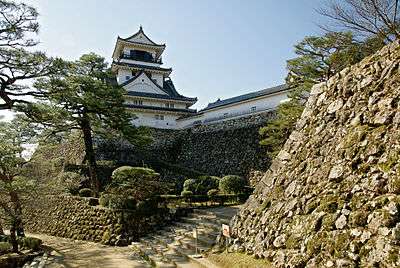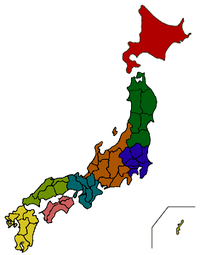Kōchi Castle
| Kōchi Castle 高知城 | |
|---|---|
| Kōchi, Kōchi Prefecture, Japan | |
 | |
| Type | Hirayamashiro (hilltop castle) |
| Height | Five stories (tenshu) |
| Site information | |
| Condition | All the buildings in the honmaru (innermost bailey) are original, dating from 1729 to 1753. Most of the other parts of the castle were torn down during the Meiji Restoration. |
| Site history | |
| Built | 1601 to 1611 |
| Built by | Yamanouchi Kazutoyo |
| In use | 1611 to 1868 |
| Materials | Earth, stone, and wood |
Kōchi Castle (高知城 Kōchi-jō) is a castle located in Kōchi, Kōchi Prefecture, Japan.
History
Following the Battle of Sekigahara in 1600, Kōchi Castle was constructed in what was then the province of Tosa. It was built by Yamanouchi Kazutoyo, who took control of the province after the Tokugawa victory. The castle was constructed as part of the move from Urado to the more defensible Otakasa (alt. Odakasa) area.[1]
Construction was begun in 1601 and was completed in 1611. Much of the original fortress burned down in 1727; it was reconstructed between 1729 and 1753 in the original style. The castle underwent major restoration from 1948 to 1959. Though no battles were fought at the castle, it is noteworthy because the castle is the original structure, and not a post-war replica. It is also the only castle in Japan to retain both its original tenshu, or keep, and its palace, the residence of the local Daimyo.[2] In fact, it is the only castle to have all the original buildings in the honmaru, or innermost ring of defense, still standing.
Otakasa Hill

Two previous attempts were made to build castles on Otakasa Hill. Both failed. The first attempt was by Otakasa Matsuomaru sometime during the late Heian or Kamakura periods. The second was in 1588 by the conqueror of Shikoku, Chōsokabe Motochika. The area around the hill at this time was extremely swampy, due to the influx of alluvial sediments from the Kagami River. Consequently, previous builders were never successful in establishing a permanent fortress on the site where Kōchi Castle stands today.[3]
National Treasure Status
As one of only twelve intact castles in Japan, Kōchi Castle was popularly called a National Treasure (国宝) before the 1950 National Treasure Protection Law (文化財保護法施) was enacted. After the law was passed, it was demoted to the status of Important Cultural Asset (重要文化財).[4]

In popular culture
Kōchi Castle can be seen in the background of the animated film I Can Hear the Sea by Studio Ghibli, during the class reunion scene.
The castle figures prominently in the film The Harimaya Bridge. Key scenes in the movie take place in the courtyard just inside the Oteman Gate, on the top level of the castle itself, and at the entrance to the castle grounds just outside the Oteman Gate.
Structure
Two rivers, the Kagami River and the Enokuchi River, form the outer moat of the castle.[4] The tower is five stories high and sits atop Otakasa Hill, commanding an extensive view of the city. It rises above the Kaitokukan (palace), which was constructed in the Shoin style of the Edo period. The castle retains this structure today and has been fitted with period-appropriate items in the lower rooms.
In addition to a tearoom, genkan (entrance area), and latrine, the Kaitokukan contains eight traditional rooms, ranging in size from three to twelve tatami. It is surrounded by a veranda on the east and south sides. The Kaitokukan also burned during the fire of 1727, but it was not repaired until 1747, with work completed in 1749.[2]
Visiting

Kōchi Castle is located in downtown Kōchi. The main entrance is directly across from the west entrance of the Obiyamachi shopping area. Visitors are asked to remove their footwear before entering the building, however slippers are provided.
As the castle is quite old, the tatami rooms are visible but not accessible. There is a small museum area with information entirely in Japanese. This museum houses several cultural artifacts of the Tosa region not native to the castle itself. The upper rooms of the tower are all empty, but visitors are allowed to climb to the top. There is a railing but no net around the balcony.
Handicap access is extremely limited, as the approach to the castle involves many steps, and there is no elevator.
The castle grounds are now a public park, and a popular location in spring for hanami. They contain the Prefectural Library and the Kōchi Literary Museum, in addition to statues of notable scions of the Yamanouchi family.[1]
References
- 1 2 Kōchi City Online Guide, "Sightseeing in Kochi City" in English (archive)
- 1 2 Architecture in the Feudal Style: Japanese Feudal Residences, Hashimoto Fumio, trans. and adapted by H. Mack Morton, Kodansha International Ltd. and Shinonbu, 1981, pp. 144-6
- ↑ Kochi City Online Guide, "History" in English
- 1 2 Wikipedia page on Kōchi Castle in Japanese
Literature
- Mitchelhill, Jennifer (2013). Castles of the Samurai:Power & Beauty. USA: Kodansha. ISBN 978-1568365121.
- Schmorleitz, Morton S. (1974). Castles in Japan. Tokyo: Charles E. Tuttle Co. ISBN 0-8048-1102-4.
- Motoo, Hinago (1986). Japanese Castles. Tokyo: Kodansha. p. 200. ISBN 0-87011-766-1.
External links
![]() Media related to Kochi Castle at Wikimedia Commons
Media related to Kochi Castle at Wikimedia Commons
- Kōchi Castle official site in Japanese
Coordinates: 33°33′40″N 133°31′53″E / 33.56111°N 133.53139°E
